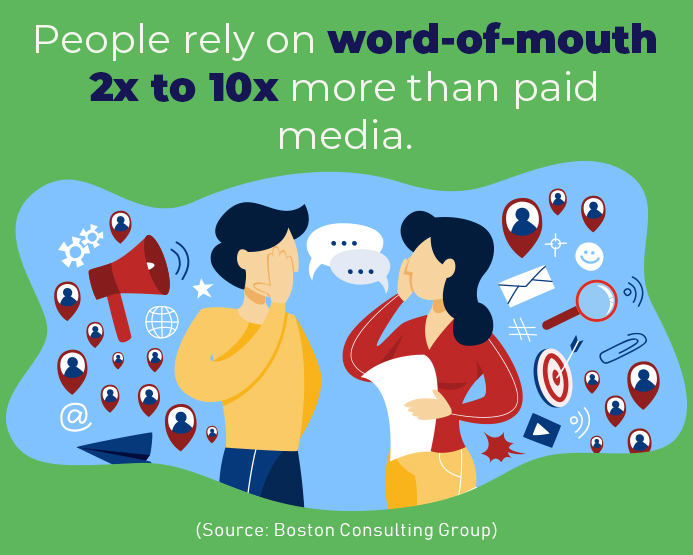How to Get Patient Referrals
Posted on
When you are getting referrals, it means that your patients believe in your offerings enough to put their reputation on the line. They want to be known among their family and friends for giving solid advice – and they are willing to make you a part of that.
Most referrals come from “word-of-mouth.” This is simple enough: One of your patients is asked a question in your specialty by some friend or colleague, and your patient recommends your brand for no other reason than you are the best fit.
There are two essential things to notice here:
To get referrals, you need to be on your patients’ minds
If you have a strong relationship with your patients, chances are they will not forget about you. However, they will have to go one step further and remember you at the moment your mention is needed – and that is the challenging part.

Most referrals come from goodwill
Often, patients drive referrals because they believe they are making the best recommendations. But this does not mean that you cannot come up with creative ways to spark frequent and more high-quality referrals.

Ways to Increase Referrals
Referrals should be treated like any other healthcare marketing strategy. To grow it and to benefit from it, you must work on these two levers: brand awareness and offer awareness.
Here are some of the best ways:
1. Look for opportunities
The best patient referrals come after the patient has experienced the value that you are capable of delivering.
Would you ask your boss for a raise right after you missed your monthly targets? This is the reason why it is neither appropriate nor effective to request a referral when you are under-delivering on promises.
In order to set yourself up for success, keep your patients up-to-date on the results they achieve using your products or services. This will keep them happy, and they will want to spread the word about your services. The entire process ideally starts with a successful onboarding so patients will have a clear sense of expectations and a timeline to reach that point.

2. Act on positive experiences
To accumulate more patient referrals, you must prove your services are referral-worthy.
In order to assure your patients that you are meeting and exceeding their needs and expectations, it is essential to gather and act on their feedback.
You can use any reputable online survey software to whip up and distribute patient satisfaction surveys in order to keep tabs on what you are doing right.
However, before you send off a survey, be sure you are positioning it in a way that is going to produce the most accurate results. Write practical survey questions and choose survey types that best suit your needs.
3. Introduce a patient loyalty program
Your loyal patients are probably going to be the ones who refer your practice the most. Acknowledge these patients by creating a loyalty program that rewards them for advocating your services on your behalf.

This system could be a premium membership or points-based. You may choose to extend it beyond just patient referrals. Regardless of how you do it, make sure your patients feel valued, and they will be inclined to help you.
4. Exceed patients’ expectations
Word-of-mouth is an excellent way to propel referrals for your medical practice. However, it is mostly dependent on patient loyalty, which means this is something you have to earn.
If you want to get your patients raving about your services, you have to delight them.
Go above and beyond for your patients’ expectations, not just by achieving health goals with them but by sharing their success on social networks, citing them in your blogs and proving to be an indispensable resource for them. But make sure the patient information that you share adheres to HIPAA guidelines, and never share any personal information without the patient’s written consent.
5. Align with patients’ values
Do you research about what your patients value before asking for a referral? If yes, you will find it easier to align your incentive with those values and give them an idea of the impact they will have with a referral.
For instance, if one of your patients is associated with nonprofit fundraising, or if you know they are personally or professionally invested in a cause, you could reward them for good-quality referrals with a donation in their name. Basic gestures can go a long way toward proving to patients that your relationship is a strong partnership, not just a transaction.
6. Offer incentives to patients
Who likes to work for free? Well, nobody. So, if you want to sweeten the deal and make sure patients scour their networks for an active referral, offer them something in return. Whether it is a Starbucks gift card or a free consultation, give something back to your patients for connecting you with leads. They deserve it.
One of the proven ways to organize incentive offers is to set up a program that oversees referral agreements. These agreements can help your medical practice continually generate substantial numbers of leads by creating a system that rewards referring patients.

7. Make the referral process simple
You should always make it easy to share your products and refer your brand. You can even consider prominently featuring a “Refer” tab at the top of your website or blog pages.
Patients are not necessarily going to know that your practice has a referral program in place. Even the most frequently visiting patients may not be getting your offers, despite all of your best efforts. Do not assume that the people visiting your practice know about your referral program, even if they are repeat patients.
When you have patients who do know about your referral program, do not make them go hunting for it on your website. Instead of burying the program information in some dark corner of your website, feature it prominently. Have a button on your homepage that encourages patients to join your program and reap the benefits. Prominently featuring the referral program is key to getting patients to refer.
Conclusion
By investing effort, time and engagement into your medical practice’s referral programs, you can reap the benefits of one of the lowest cost-per-acquisition healthcare marketing methods available to you. From increased patient trust and active conversations about your services on social networks, all the way to higher sales and revenue, these benefits can be enjoyed by any medical practice.

 Why Good communication Matters in Healthcare
Why Good communication Matters in Healthcare De-Escalation Tips for Handling Aggressive Patient..
De-Escalation Tips for Handling Aggressive Patient.. Reaching The Right Audience Through Target Marketi..
Reaching The Right Audience Through Target Marketi..